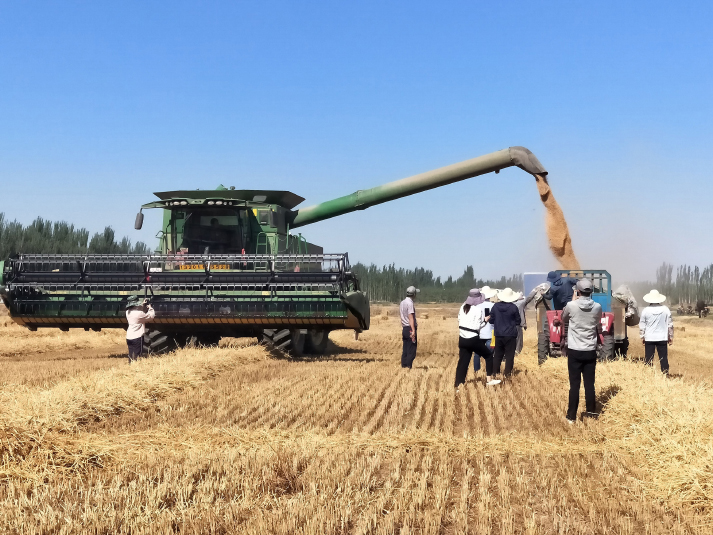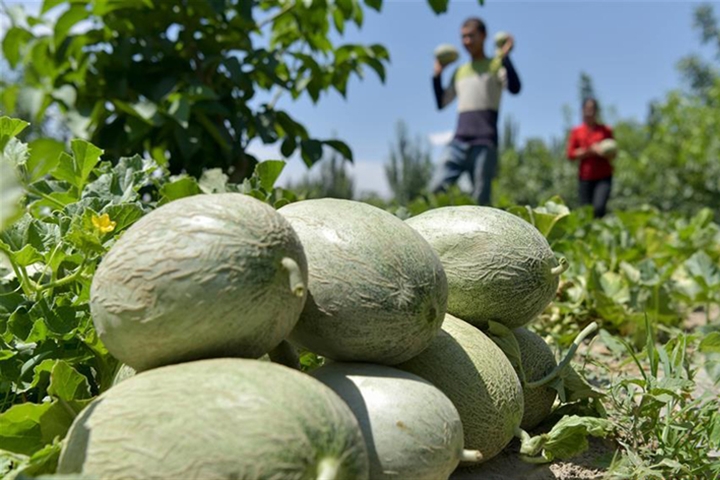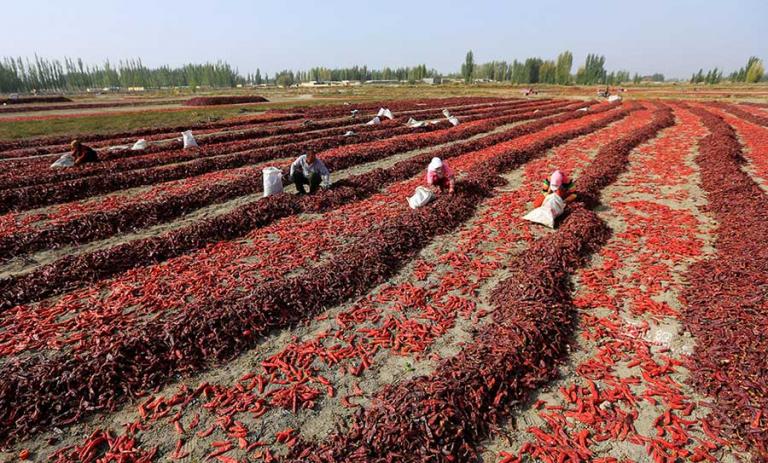Cash crops
4 min readWith the continuous ad justment and optimization of agricultural structure, cash crops growing industry in Xinjiang with cotton, sugar beet and fruit as the leading cash crops is developing rapidly, and has quickly become the leading industry of agriculture. Among them, cotton industry in Xin jiang has become the second industry behind oil industry, and indicators in terms of growing area, yield per unit, total production, purchase volume and allocating volume have ranked all first in China for many years. Xin jiang’s main industrial crops are cotton, canola, flax, safflower, sugar beets, hops and tomatoes.

In 2011, the cotton planting area in Xin jiang reached 1,638,100 hectares,12.15% higherover the previous year, and the production volume was 2,897,700 tons, accounting for 44% of the total production of China, ranking first in China; oilseeds planting area was 264,300 hectares, and the yield was 668,000 tons, accounting for 2.0% of the total yield in China, ranking 15th in China; the per capita oil occupation was 30.4 kilograms, ranking ninth 9th in China; beet cultivation area was 64,000 hectares and the yield was 5.19 million tons, accounting for 48.4% of total yield in China, ranking first in China. Fruit production with apples, pears, grapes and melon as the main types was 10.36 million tons, accounting for 455% of the total output in China, ranking 7th in China; wherein grape production was 1.755 million tons, accounting for 19.36% of China’s total output and ranking first in China.
In 2011, the total fruit area in Xin jiang was 990,300 hectares, among which there were 83,300 hectares of apple,69,900 hectares of pear,135,500 hectares of grapes (among which there are 43,000 hectares of seedless grapes),193,600 hectares of apricot,12,900 hectaresof peach,45.61 million hectares of red dates,14,200 hectares of pomegranate, and the total fruit yield production was 6,016,500 tons. After years of efforts, the total fruit area in Xinjiang has ranked 6th in China, and a national quality fruit production base mainly based on red dates, walnuts, apricot, pear and grape has formed.
Cash crop production bases in Xinjiang:
Quality land cotton areas in Southern Xinjiang: include 28 counties(cities), namely, Yengisar County, Yuepuhu County, Shufu County, Zepu County, Yecheng County, Jiashi County, Shule County, Markit County, Bachu County, Shache County, Kashgar City in Kashgar Prefecture, Aksu City, Xinhe County, Wensu County, Shaya County, Kuqa County Awat County, Keping County in Aksu Prefecture, Luntai County, Korla City, Yuli County, and Heshuo County, Qiemo County in Bayingolin Prefecture, Luopu County, Moyu County, Hotan County, Keriya County in Hotan Prefecture, and Akto County in Kizilsu KirghizAutonomous Prefecture. Long stapled cotton areas mainly include Awat County, Shaya, Korla City, Bachu County and Markit County. Middle long stapled cotton areas mainly include Yuepuhu County, Markit County, Bachu County, Shache County, Aksu City, Shaya County, Kuqa County, Korla City, Luntai County and Yuli County.

Quality land cotton areas in Northern Xin jiang and Eastern Xin jiang mainly include: ten counties(cities), namely, Changji City, Manas County and Hutubi County in Changji Prefecture, Wusu City, Shawan County and Hefeng County in Tacheng Prefecture, Jinghe County, Bole City in Boertala Mongolian Autonomous Prefecture and Kumul City in Kumul Prefecture. Middle long stapled cotton areas in Northern Xinjiang mainly include Wusu City and Jinghe County and the key construction base of organic cotton is Hefeng County.
0il bases mainly include:18 counties(cities), namely, Yining County, Huocheng County, Turks County, Zhaosu County, Xinyuan County, Qitai County, Hutubi County, Jimsar County, Tacheng City, Emin County, Toli County, Bole City, Wenquan County, Altai City, Habahe County, Burqin County, Fuhai County and Qinghe County.
Sugar beets areas mainly include:27 counties(cities), namely, Yining City, YiningCounty, Huocheng County, Qapqal County, Xinyuan County, Turks County, Nilka County, Wusu City, Tacheng City, Emin County, Shawan County, Changji City, Hutubi County, Manas County, Qitai County, Jimsar County, Mori County, Bole City, Wenquan County and Hejing County, Yanqi County, Bohu County, Wushi County, Baicheng County, Altai City, Fuhai County and Burqin County in lli Kazak Autonomous Prefecture, Changji Hui Autonomous Prefecture, Bortala Mongol Autonomous Prefecture and Bayingolin Mongol Autonomous Prefecture.
Melon bases mainly include: quality cantaloupe base in Turpan Prefecture with the precocious and facilities ones as the main types supplied in four seasons; middle degree ripe melon bases in Kumul Prefecture, Changji Prefecture and Bortala Prefecture; late maturing melon bases in Kumul Prefecture, Kashgar Prefecture and Altai Prefecture.
Chili processing base mainly include: relevant counties(fields) in Bortala Prefecture, Tacheng Prefecture, Changji Hui Autonomous Prefecture, Aksu Prefecture and Kashgar Prefecture.
Tomato processing bases mainly include the two advantageous regions of the southern margin of the Junggar Basin of Northern Xin jiang and Yanqi Basin in Southern Xin jiang. The southern margin of the Junggar Basin includes Changji City, Manas County, Hutubi County, Jimsar County in Changji Prefecture and Wusu City, Shawan County in Tacheng Prefecture.
Yanqi Basin planting areas include Bohu County, Yanqi County and He jing County in Bortala Prefecture. Xin jiang is actively promoting the development of new producing areas in Baicheng County and Wushi County.
Melon seed producing areas mainly include: Emin County, Tacheng City in Tacheng Prefecture, Qitai County in Changji and Habahe County, Fuhai County in Altai Prefecture.
Flax bases are mainly in producing areas in Ili Prefecture, Changji Prefecture and Tacheng Prefecture.
Spice crops production bases mainly include: Yanqi Basin, Ii Valley, Turpan Depression, Kashgar Prefecture and some counties and cities of Aksu Prefecture and Hotan Prefecture.Produced spices include lavender, roses, mint and rest cumin(cumin), etc.









